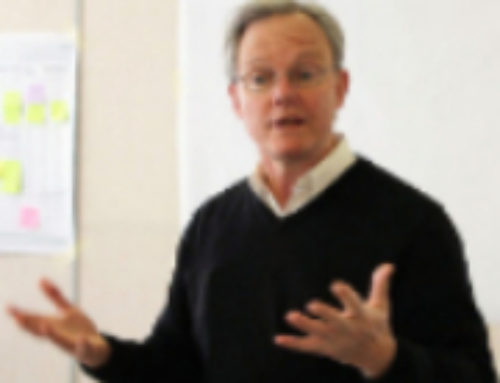— Humans Evolve While Enterprises Stay Mired in Industrial Era —
People are increasingly disillusioned with worklife inside organizations. Survey after survey shows employees disengaged from their jobs, and not only in the United States: Workers everywhere complain about workplace politics, bureaucracy, infighting, stress, lack of meaning, burnout, and resignation.
It’s a profoundly human problem — common to businesses, schools, government organizations, and hospitals — and experienced by ordinary workers, managers, and CEOs alike.
Why?
 One reason workers are disengaged is that human consciousness and behavior has started transcending the industrial era, yet today’s enterprises remain industrial-age hierarchies built on a command-and-control worldview. “Parent-child” power relationships dominate workplaces, sapping worker autonomy and responsibility and crowding out adult-to-adult relationships based on self-management and self-directed action. Meanwhile, the Internet has precipitated a new worldview — one that recognizes the profound possibilities of distributed intelligence instead of top-down hierarchy, according to Frederic Laloux, author of Reinventing Organizations.
One reason workers are disengaged is that human consciousness and behavior has started transcending the industrial era, yet today’s enterprises remain industrial-age hierarchies built on a command-and-control worldview. “Parent-child” power relationships dominate workplaces, sapping worker autonomy and responsibility and crowding out adult-to-adult relationships based on self-management and self-directed action. Meanwhile, the Internet has precipitated a new worldview — one that recognizes the profound possibilities of distributed intelligence instead of top-down hierarchy, according to Frederic Laloux, author of Reinventing Organizations.
Organizational structures have always reflected human consciousness, says Laloux, and herein lies the key to understanding and restoring worker engagement. Laloux uses colors and metaphors to characterize stages of organizational development, each of which has brought tremendous economic and social progress. Here are the five most recent stages:
Red: Impulsive
![]()
Red organizations lack formal hierarchies and job titles. Like tribes, street gangs, and mafias, they focus on the continuous exercise of power in interpersonal relationships. Red organizations scale poorly and their bosses are frequently toppled. Metaphor: wolfpack.
Amber: Conformist
![]()
Amber organizations represent mankind’s leap from a tribal world to the age of agriculture, states and civilizations, institutions, bureaucracies, and organized religions, according to Laloux. Amber organizations replaced the “my way or the highway” egocentrism of red organizations with “us or them” ethnocentrism. Metaphor: army.
Orange: Achievement
![]()
Most modern global corporations are Orange enterprises that used innovation, accountability, and meritocracy to achieve results far surpassing previous organizational forms, says Laloux. They think of themselves as machines and use jargon such as units, layers, inputs, outputs, efficiency, effectiveness, scoping problems, moving the needle, information flows, and scaling solutions. Yet much of the Orange economy is based on fabricated needs and is increasingly recognized as financially or ecologically unsustainable. Metaphor: machine.
Green: Pluralistic
![]()
Sustainability is the watchword of Green organizations, which would ideally prefer to eliminate power and hierarchy altogether, says Laloux. Green enterprises are culture and value-driven, and emphasize belonging and harmony. Metaphor: family.
Teal: Evolutionary
![]()
Teal organizations consider themselves living organisms with souls and purposes, and they are therefore concerned with questions of inner rightness rather than extrinsic measures of achievement or success. Employees are trusted and held accountable for managing their own work within autonomous groups, with these groups making own decisions regarding everything from hiring and firing to capital expenditures, says Laloux. Metaphor: living organism.
As seen in Reinventing Organizations, Teal organizations show that there’s another way to run enterprises: one that eliminates most meetings, most managers, and most conventional notions about how employees and their talents should be “managed.” Employees and the autonomous groups to which they belong enjoy true power — and true responsibility.
This approach is often described as decentralized, self-managed, or holacracy (Zappos recently made headlines by announcing its shift to holacracy). Yet it’s hardly something new. Writes Laloux:
… self-management is not a startling new invention by any means. It is the way life has operated in the world for billions of years, bringing forth creatures and ecosystems so magnificent and complex we can hardly comprehend them.
Laloux shows us that a handful of organizations have been operating this way successfully for decades, in fields as diverse as nursing, food processing, education, electric power generation, and precision machinery manufacturing — with employee numbers ranging from 100 to nearly 10,000. They have achieved superior financial results and marketplace reputations for top quality. More important, says Laloux, their workers are dedicated and satisfied with worklives inspired by meaning and purpose.
Reinventing Organizations readers can be forgiven for thinking Laloux is a Pollyanna idealist ignorant of the hard realities of today’s marketplaces. But Laloux spent ten years as a McKinsey consultant before researching and writing the book, and he proactively addresses the many criticisms of self-directed workplaces. In doing so, he marshals compelling evidence and has convinced this reader, at least, that the shift to enlightened Teal workplaces is inevitable
That’s why we’re so pleased that Frederic Laloux will deliver a remote address at our forthcoming Talent Management Camp. Given the very real progress of Teal organizations, the question is: How can anyone truly manage talent other than their own?
Tim Clark often found himself disengaged from work, until he became an entrepreneur. His most recent book is Business Model You.



